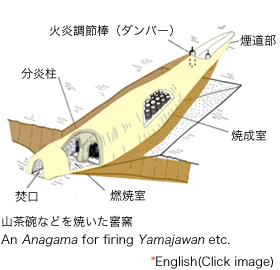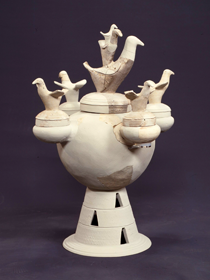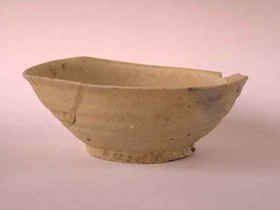美濃の窯
Kilns Used to Fire Mino Ware
Back
窖窯
Anagama
Anagama

朝鮮半島から、「ロクロ」成形技法と窯による焼成技術が5世紀ころに伝えられました。それまでの野焼きによる方法と違い、1000℃以上の焼成温度で硬く焼きしめる技術でできた製品が「須恵器」です。この須恵器がわが国の陶器へつながる源であり、日常生活では土師器(はじき)と併用され、古墳にも副葬されています。
可児市内の柿田馬乗洞で発見された須恵器の窯(消滅)は、東濃地方最古の窯で7世紀初め頃のものと考えられます。その他、大森の笹洞古窯でも8~9世紀には焼かれていました。
平安時代の10世紀頃になると、分炎柱が造られるようになり、熱効率も良くなりました。その頃には可 児市でも、灰釉が施された「白瓷(灰釉陶器)」が生産されます。また、平安時代の終り頃から室町時代にかけては、「山茶碗」と呼ばれる無釉のやきものなどが焼かれました。
可児市内の柿田馬乗洞で発見された須恵器の窯(消滅)は、東濃地方最古の窯で7世紀初め頃のものと考えられます。その他、大森の笹洞古窯でも8~9世紀には焼かれていました。
平安時代の10世紀頃になると、分炎柱が造られるようになり、熱効率も良くなりました。その頃には可 児市でも、灰釉が施された「白瓷(灰釉陶器)」が生産されます。また、平安時代の終り頃から室町時代にかけては、「山茶碗」と呼ばれる無釉のやきものなどが焼かれました。
Both the potter’s wheel, for shaping clay, and kiln technology, enabling high-temperature firing, were transmitted to Japan from the Korean Peninsula during the fifth century. Unlike the noyaki (open firing) that had been carried out prior to this, the use of a kiln made possible temperatures in excess of one thousand degrees centigrade, leading to the production the high-fired, unglazed Sue ware. This Sue ware was the origin of Japanese pottery and together with Haji ware, it was used in both daily life and as grave goods in kofun burial mounds.
The site of a Sue ware kiln that was unearthed at Kakida Umanoribora in Kani City is believed to be the oldest kiln in the Tōnō district (southeastern Gifu Pref.), dating back to the beginning of the seventh century. In addition, another old kiln was discovered at Ōmori Sasabora that is thought to date from the eight to ninth centuries.
In around the tenth century, a ‘flame-dividing pillar' was added to the entrance of the firing chamber, improving heat efficiency. At around this time, Shirashi ware, which had a coating of ash glaze applied, was being produced in present-day Kani City while Yamajawan, unglazed bowls, were also fired from around the late twelfth century.
The site of a Sue ware kiln that was unearthed at Kakida Umanoribora in Kani City is believed to be the oldest kiln in the Tōnō district (southeastern Gifu Pref.), dating back to the beginning of the seventh century. In addition, another old kiln was discovered at Ōmori Sasabora that is thought to date from the eight to ninth centuries.
In around the tenth century, a ‘flame-dividing pillar' was added to the entrance of the firing chamber, improving heat efficiency. At around this time, Shirashi ware, which had a coating of ash glaze applied, was being produced in present-day Kani City while Yamajawan, unglazed bowls, were also fired from around the late twelfth century.

鳥つまみ蓋付須恵器
宮之脇11号噴出土 川合考古資料館蔵
Pedestal Jar, with lid and bird shaped handles, Sue Ware (excavated from the Miyanowaki No. 11 mound), belonging to Kawai Archaeological Museum
宮之脇11号噴出土 川合考古資料館蔵
Pedestal Jar, with lid and bird shaped handles, Sue Ware (excavated from the Miyanowaki No. 11 mound), belonging to Kawai Archaeological Museum

山茶碗 矢戸上野2号窯出土 可児郷土歴史館蔵
Yamajawan (excavated from the Yato-Ueno No. 2 kiln), belonging to the Kani Local History Museum
Yamajawan (excavated from the Yato-Ueno No. 2 kiln), belonging to the Kani Local History Museum